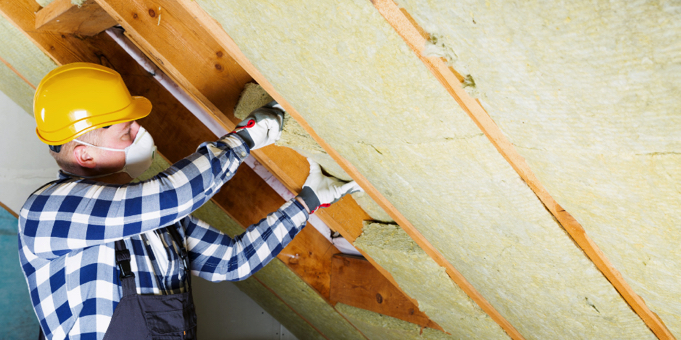If you’ve had a home energy assessment for insulation, you may have been told you need additional soffit vents, or need to remove the old knob-and-tube wiring in your home, or that you should use blown-in cellulose. Feeling confused? We don’t blame you! Home improvements often mean learning a whole new set of terms in order to make informed decisions about the work being done. To help, we put together a glossary of some of the words you should know when it comes to insulation and air sealing to make this process a little easier.

Fiberglass batt insulation
R-Value: a measurement of how well insulation can prevent heat from entering or leaving a home. The higher the R-value, the better the insulation performance (and typically the more expensive).
Fiberglass insulation: the most common type of insulation used, made up of tiny glass fibers. Comes in batts (sheets or blankets of insulation) as well as loose fill – this is the fluffy, pink material that often comes to mind when you think about insulation. Typically has an R-value of 3.1 to 3.8 per inch.

Blown-in cellulose insulation
Cellulose insulation: made from shredded newspaper, and is frequently blown in loose to cover attic floors or fill wall cavities. Has a similar R-value to fiberglass batts of 2.2 to 3.8 per inch. It’s effective and cheap but can be sensitive to moisture.
Spray foam: this type of insulation creates an airtight seal, and has a high R-value (and cost). It comes in closed-cell foam (expands and is denser, with R-value of 6.5) and open-cell foam (more spongy, with R-value of 3.5). It is very energy efficient, but contains chemicals like polyurethane.

Spray foam insulation
Guides to Types of Insulation: [1] [2][3]
Unconditioned attic: an attic that is vented, with air flowing in at the roof line and out at the top of the roof. Typically just the floor of the attic is insulated, sealing it off from the rest of your home.
Conditioned attic: an attic that is fully insulated and sealed, with no air vented through. HVAC systems located in the attic tend to run more efficiently in a conditioned attic space.
Soffit vents: vents that allow air to enter the attic along the roofline. They work in conjunction with ridge caps to ventilate your attic properly (see below).
Ridge cap: a vent at the peak of your roof where air leaves your attic.
Baffles: chutes that are installed on the inside of your roof to help air flow up from the soffit vents to the ridge cap. They prevent the soffit vents from getting blocked by insulation.

Knob-and-tube wiring (K&T): old wiring used from the 1880s to 1930s that cannot have insulation installed around it for safety reasons. If you live in an older home, a licensed electrician can identify and remove this old wiring and sign off that it’s been removed for MassSave.

Blower door test
IC rated lights: recessed lights that are IC (Insulated Contact) rated are safe to install insulation over. If lights are non-IC rated, insulation placed over them pose a fire hazard. A licensed electrician can identify if you have non-IC fixtures and can either upgrade them or direct MassSave to avoid insulating over them. There are several ways to identify them yourself as well.
Blower door test: blower doors are powerful fans that insulation and air sealing professionals can use to identify where air is leaving or entering your home. This helps determine where your home needs air sealing.
We hope this glossary makes you feel more confident about weatherizing your home. If you have any additional questions about your insulation project, email info@greennewton.org or schedule an appointment with a City of Newton Energy Coach today!


Recently on Twitter